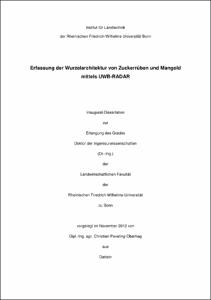Erfassung der Wurzelarchitektur von Zuckerrüben und Mangold mittels UWB-RADAR

Erfassung der Wurzelarchitektur von Zuckerrüben und Mangold mittels UWB-RADAR

| dc.contributor.advisor | Schulze Lammers, Peter | |
| dc.contributor.author | Peveling-Oberhag, Christian | |
| dc.date.accessioned | 2020-04-18T13:15:16Z | |
| dc.date.available | 2020-04-18T13:15:16Z | |
| dc.date.issued | 27.09.2013 | |
| dc.identifier.uri | https://hdl.handle.net/20.500.11811/5555 | |
| dc.description.abstract | Die Züchtung von Nutzpflanzen ist ein wichtiger Prozess für die Entwicklung leistungsfähiger neuer Pflanzensorten. Die schnelle Bonitur einer Vielzahl von Nutzpflanzen im Rahmen einer pflanzenzüchterischen Fragestellung (Rapid Phenotyping) erfordert deshalb hochauflösende und nicht-destruktive Sensorsysteme. Für Wurzelfrüchte, deren ertragsrelevanter Teil sich unter der Erdoberfläche entwickelt, stehen bisher allerdings nur solche Sensorsysteme zur Verfügung, die immobil und mit hohen Kosten behaftet sind. Ziel der vorliegenden Arbeit war es deshalb ein neues Sensorsystem auf Basis von Ultrabreitband-RADAR zu entwickeln, welches Wurzelfrüchte im Boden erfassen und Unterschiede in der Wurzelarchitektur voneinander diskriminieren sollte. Dabei sollte das System einfach zu transportieren, intuitiv zu bedienen und erheblich günstiger sein als bestehende Systeme (Computertomographie und Magnetresonanztomographie). Hierzu wurde ein Sensorsystem aufgebaut, welches diese Aufgaben an einzelnen Pflanztöpfen erfüllen sollte. Als Modellpflanzen wurden Zuckerrübe und Mangold ausgewählt, da hier erhebliche Unterschiede in der Entwicklung des Wurzelsystems zu erwarten waren. Die Prüfung aller wesentlichen Komponenten und Datenverarbeitungsschritte zeigte gute Ergebnisse und lieferte eindeutige Informationen zur Konfiguration des Sensorsystems hinsichtlich Antrieb, Antennenpolarisation, Antennenabstand und Datenverarbeitung. Während bei der Untersuchung von Testkörpern eindeutige Ergebnisse erzielt wurden, die die Leistungsfähigkeit des Sensorsystems unter Beweis stellten, war die Applikation auf reales Pflanzenmaterial weniger erfolgreich. Das System lieferte zwar Informationen über den betreffenden Wurzelkörper, es zeigte sich jedoch, dass diese für die gleiche Pflanze weder konsistent waren, noch dass Unterschiede hinsichtlich der Größe und der Morphologie des Wurzelkörpers erfasst werden konnten. Eine Diskriminierung der Wurzelarchitektur anhand der Sensordaten war deshalb nicht möglich. Für eine zukünftige Applikation des Sensorsystems sind deshalb Modifikationen notwendig, die vor allem die Konfiguration des RADAR-Systems, die Ausgestaltung der Antennen und die Datenauswertung betreffen. | en |
| dc.description.abstract | Detection of root architecture of sugar beets and leaf beets using UWB-RADAR Plant breeding is highly important for development of efficient crops. Rapid assessment of plant-parameters within the breeding process (Rapid Phenotyping) is crucial. Therefore non-destructive sensors are needed for recognition of plant parameters. However, in case of root-crops the assessment of the buried part of the plants is difficult and only a few sensor-systems are able to analyze the root structure in a non-destructive way. In most cases these sensor-systems are immobile and highly expensive. Therefore the aim of this thesis was to develop a novel sensor-system based on ultra-wideband RADAR, which on the one hand would be able to analyze the root-structure with high resolution in a non destructive way and on the other hand would be more valuable and mobile compared to the existing systems (CT and MRI). Based on these ideas a sensor-system was developed, which was meant to be able to match the requirements. The sensor system has been tested experimentally using single plant pots under greenhouse-conditions. For testing the system with real plants sugar beet and leaf beet have been selected as models, because they have significantly different root architecture. Within the experiments all components of the sensor system and all steps of data processing showed good results. Experiments with test bodies delivered clear information about optimization of the system’s drives, antenna positioning and polarization and gave recommendations on data processing. However, in case of real plant material the results were not as good as expected. Sensor data was generated for single plants, but it was neither consistent for the same plant nor information was gathered about size and morphological parameters on the root system. Therefore separation of different root architecture based on the sensor data was not possible. Further applications of the sensor-system would require major modifications of the whole system including configuration of the RADAR, antenna design and improvement of the data processing software. | en |
| dc.language.iso | deu | |
| dc.rights | In Copyright | |
| dc.rights.uri | http://rightsstatements.org/vocab/InC/1.0/ | |
| dc.subject.ddc | 630 Landwirtschaft, Veterinärmedizin | |
| dc.title | Erfassung der Wurzelarchitektur von Zuckerrüben und Mangold mittels UWB-RADAR | |
| dc.type | Dissertation oder Habilitation | |
| dc.publisher.name | Universitäts- und Landesbibliothek Bonn | |
| dc.publisher.location | Bonn | |
| dc.rights.accessRights | openAccess | |
| dc.identifier.urn | https://nbn-resolving.org/urn:nbn:de:hbz:5n-33314 | |
| ulbbn.pubtype | Erstveröffentlichung | |
| ulbbnediss.affiliation.name | Rheinische Friedrich-Wilhelms-Universität Bonn | |
| ulbbnediss.affiliation.location | Bonn | |
| ulbbnediss.thesis.level | Dissertation | |
| ulbbnediss.dissID | 3331 | |
| ulbbnediss.date.accepted | 05.04.2013 | |
| ulbbnediss.fakultaet | Landwirtschaftliche Fakultät | |
| dc.contributor.coReferee | Biermann, Jan-Welm |
Dateien zu dieser Ressource
Das Dokument erscheint in:
-
E-Dissertationen (1118)




